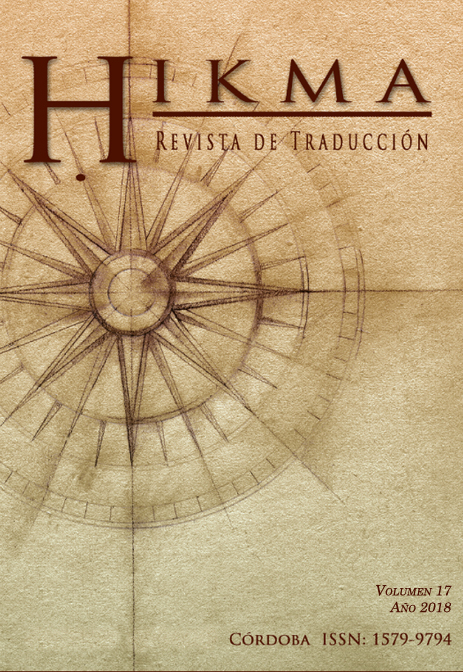Indexing a Gender Identity in Fictive Dialogue: Bucholtz and Hall’s Identity Principles in Translation
Contenido principal del artículo
Resumen
The framework for the analysis of identity construction proposed by Bucholtz and Hall (2005) has proved a useful heuristic tool for the study of identity formation in interaction. The aim of this article is to tentatively apply the model to fictive dialogue in translation and test its validity in two ways, firstly, as a framework for the descriptive analysis of identity formation in translation, and secondly, as a tool that can aid the translation of fictive dialogue.
The case study is Janice Angstrom, wife of the eponymous Harry Angstrom, in Updike’s «Rabbit» books. Using Bucholtz and Hall’s model, the descriptive analysis will compare the source and target texts for discursive mismatches that distort the intersubjective construction of her identity in interaction. The metapragmatic information yielded by the application of the model will then inform the proposed alternatives, guided by the principles of the model.
Descargas
Detalles del artículo
Los autores que publican en esta revista aceptan las siguientes condiciones:
- Los autores conservan los derechos de autor y conceden a la revista el derecho de primera publicación con el trabajo simultáneamente bajo una Licencia de Atribución Creative Commons que permite a otros compartir el trabajo con un reconocimiento de la autoría del trabajo y la publicación inicial en esta revista.
- Los autores pueden llegar a acuerdos contractuales adicionales por separado para la distribución no exclusiva de la versión publicada del trabajo en la revista (por ejemplo, enviarlo a un repositorio institucional o publicarlo en un libro), con un reconocimiento de su publicación inicial en esta revista.
- Se permite y anima a los autores a publicar sus trabajos en línea (por ejemplo, en repositorios institucionales o en su sitio web) antes y durante el proceso de presentación, ya que puede dar lugar a intercambios productivos, así como a una citación más temprana y mayor del trabajo publicado (Véase El efecto del acceso abierto).
Bibliografía
Assis Rosa, A. (2015). Translating orality, recreating otherness. Translation Studies, 8(2), pp. 209-225.
Berman, A. (2000). Translation and the trials of the foreign. In Venuti, L. (Ed.), The Translation Studies Reader (pp.276-289). London and New York: Routledge.
Berthele, R. (2000). Translating African-American Vernacular English into German: the problem of “Jim” in Mark Twain’s Huckleberry Finn. Journal of Sociolinguistics, 4(4), pp. 588-613.
Boswell, M. (2001). John Updike’s Rabbit Tetralogy: Mastered Irony in Motion. Columbia: University of Missouri Press.
Brumme, J. (2012). Traducir la voz ficticia. Berlin and Boston: Walter de Gruyter.
Brumme, J. and Espunya, A. (2012). The Translation of Fictive Dialogue. Amsterdam and New York: Rodopi.
Bucholtz, M. and Hall, K. (2005). Identity and interaction: a sociocultural linguistic approach, Discourse Studies 7(4-5), pp.585-614.
De Bellis, J. (2000). The John Updike Encyclopedia. Westport, Connecticut and London: Greenwood Publishing Group.
Del-Tese-Craviotto, M. (2008). Gender and sexual identity authentication in language use: the case of chat rooms. Discourse Studies, 10(2), pp.251-270.
Eckert, P. (1990). The whole woman: sex and gender differences in variation. Language Variation and Change, 1(1989): pp. 245-267.
Eckert, P. and McConnell-Ginet, S. (2003). Language and Gender. Cambridge: Cambridge University Press.
Gordon, M. (1991). Good and Dead Girls: And Other Essays. New York: Viking.
Johnstone, B. (2010). Locating language in identity. In Watt, D. and Llamas, C. (Eds.), Language and Identities (pp. 29–36). Edinburgh: Edinburgh University Press.
Joseph, J. (2004). Language and Identity: National, Ethnic, Religious. New York: Palgrave Macmillan.
Leppihalme, R. (2000). The two faces of standardization: on the translation of regionalism in literary dialogue. The Translator, 6(2): 247–69.
Litosseliti, L and Sunderland, J (2002) Gender Identity and Discourse Analysis. Philadelphia and Amsterdam: John Benjamins Publishing.
Livia, A. (2003). ‘One man in two is a woman’: linguistic approaches to gender in literary texts. In Holmes, J. and Meyerhoff, M. (Eds.), The Handbook of Language and Gender (pp. 142–58). Oxford: Blackwell.
Määttä, S. (2004). Dialect and point of view: the ideology of translation in The Sound and the Fury in French. Target 16(2): pp. 319-339.
Mango, O. (2010). Enacting solidarity and ambivalence: positional identities of Arab American women. Discourse Studies 12(5): pp. 649-664.
Ochs, E. (1992). Indexing gender. In Duranti, A. and Goodwin, C. (Eds.), Rethinking Context: Language as an Interactive Phenomenon (pp. 335-358). Cambridge: Cambridge University Press.
Pinto, S. (2009). How important is the way you say it? A discussion on the translation of linguistic varieties. Target 21(2): pp. 289–307.
Sidiropoulou, M. (2004). Linguistic Identities through Translation. Amsterdam and New York: Rodopi.
Simon, S. (1996). Gender and Translation. Culture and Identity and the Politics of Transmission. London and New York: Routledge.
Simons, M. (1983). The silencing of Simone de Beauvoir: guess what’s missing from The Second Sex. Women’s Studies International Forum 6(5): pp. 559-564.
Updike J. (1960). Rabbit, Run. New York: Knopf
Updike J. (1971). Rabbit Redux. New York: Knopf
Updike J. (1981). Rabbit is Rich. New York: Knopf
Updike J. (1990). Rabbit at Rest. New York: Knopf
Updike, J. (1990). Corre, Conejo. (Trans: Fibla, J.) Barcelona: Tusquets Editores.
Updike, J. (1992). Conejo en Paz. (Trans: Menéndez, I.) Barcelona: Tusquets Editores.
Updike, J. (1993). El regreso de Conejo. (Trans: Menéndez, I.) Barcelona: Tusquets Editores.
Updike, J (2003). Conejo es rico. (Trans: Zulaika, J.) Barcelona: Tusquets Editores.
Von Flotow, L. (1997). Translation and Gender: Translating in the ‘Era of Feminism’. Manchester: St Jerome Publishing.
Watt, D. (2010). The identification of the individual through speech. In Watt, D. and Llamas, C. (Eds). Language and Identities (pp. 76–85). Edinburgh: Edinburgh University Press.
Wolfram, W. and Schilling-Estes, N. (2006). American English: Dialects and Variation. Cambridge and Oxford: Wiley and Blackwell Publishing.

